What is anechoic contents of the gallbladder. Gallbladder sizes in adults and children, norms
Ultrasound of the gallbladder is performed separately or with complete ultrasound diagnostics abdominal cavity. It is translucent with suspicion of cholelithiasis and other pathologies. Among the main terms that will be indicated in the forms with the results of ultrasound, there may be a definition of "anechoic contents of the gallbladder." I must say that a specialist in ultrasound diagnostics does not make a diagnosis, he can only describe the data that he sees on the screen. The attending physician will deal with the interpretation of the indicators.
What is echogenicity?
In order to understand what the anechogenicity of the gallbladder can say, you need to understand the definition and properties of ultrasound. Some facts that will help to understand the essence of ultrasonic waves:
- Ultrasound is an elastic oscillation of the particles of the medium, which propagate in the form of a longitudinal wave.
- It can exist in liquid, gaseous, or solid media, but ends up in a vacuum.
- Some animals use it as a means of communication, but are not inaudible to the human ear.
It is used in the diagnosis of internal diseases due to its properties. Ultrasonic waves are absorbed by soft tissues and reflected from inhomogeneities.
The process of obtaining an image from an ultrasound machine occurs in two stages:
- wave radiation into the tissues under study;
- receiving reflected signals, on the basis of which an image is formed on the screen internal organs.
Due to the different structure and density of tissues and internal organs, they reflect differently ultrasonic waves. In addition, this property changes with various pathologies, which makes it possible to identify many diseases, including the gallbladder. To describe the resulting image, special terminology is used, which should be familiar not only to ultrasound specialists, but also to general practitioners.
Echogenicity is the ability of a tissue or organ to reflect an ultrasound beam. Various organs appear lighter or darker on the screen, and this property is determined precisely by their echogenicity.
On this basis, several types of fabrics can be distinguished:
- hyperechoic objects (bones, gas, collagen) are structures that reflect a large number of ultrasonic rays appear on the screen as centers of bright white color;
- hypoechoic ( soft tissues) - partially reflect the ultrasonic beam, are various shades gray color;
- anechoic (liquid) - these are areas that do not reflect ultrasound and look like black foci.
From this we can conclude that the anechoic contents in the gallbladder are liquid. To make a diagnosis, you need to figure out how this organ should normally look like on an ultrasound scan and what the presence of fluid in its cavity may indicate.
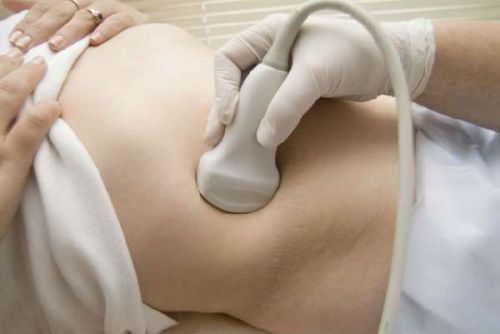
The accuracy of the results depends on the quality of the equipment and the sensitivity of the sensors.
What does a normal gallbladder look like on ultrasound?
gallbladder has a pear shape. In its structure, there are 3 main elements:
- the bottom is a wide edge that protrudes slightly beyond the liver;
- the body is its main part;
- neck - narrowing of the bladder at its exit.
The gallbladder is hollow organ, it has a wall and a cavity where bile accumulates. Like other similar organs, it is built from muscle tissue, which is lined inside by a mucous membrane with a large number of folds and glands. Outside, it is partially covered with a serous membrane.
The need for a reservoir for bile arose due to the fact that it does not enter the intestines constantly, but only in the process of digestion. Ultrasound diagnostics is carried out on an empty stomach (it is even forbidden to drink water before the study), so that bile accumulates in the bladder and it is possible to examine its contents and walls.
Bile is produced in the liver and flows through the hepatic duct to the gallbladder. If there is an immediate need for it, it moves further along the bile duct to duodenum. If this is not necessary, the sphincters contract and do not release bile from the bladder. Until food enters the stomach, it will accumulate in the gallbladder and stretch its walls. As soon as the process of digestion begins, the muscles of the walls of the bladder contract, and the muscles of the sphincter and bile duct, on the contrary, relax. Therefore, with ultrasound after eating, the bladder will be empty, and it will not be possible to accurately determine its size and nature of the contents.
Normally, the indicators of the gallbladder will be as follows:
- pear-shaped;
- dimensions: 8-14 mm long, 3-5 mm wide;
- the location is intrahepatic, only the bottom of the bladder extends beyond the liver;
- the contours are even and clear;
- wall thickness - up to 3 mm;
- homogeneous anechoic contents.
Any deviation from the norm indicates the presence of pathology. Thus, the walls of the bubble thicken when inflammatory processes, and the abnormal structure of the bladder will impede the outflow of bile, and it will accumulate in its cavity in large quantities. The contents are examined if gallstone and other diseases are suspected, in such cases it becomes echogenic.
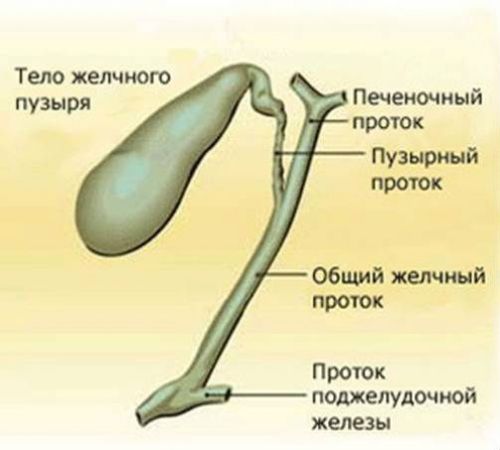
The gallbladder is a kind of bag for bile, which, when filled, has the shape of a pear.
Echogenicity of the contents of the gallbladder
The gallbladder is a reservoir for bile. In addition to it, there can normally be no liquid in the bladder cavity. If the content ceases to be echogenic, that is, a uniform black color, this gives reason to assume the presence of foreign objects.
By the nature of the change in echogenicity can be:
- focal (helminths, stones);
- diffuse (sediment, pus or blood).
The leading place in diseases of the gallbladder is occupied by stones. They may have various origins, chemical composition, shape and size and look different on ultrasound. In composition, they can be cholesterol, calcareous, pigmented and complex (of mixed origin). It is impossible to determine this on ultrasound, it is necessary to conduct tests after the extraction of stones.
According to the results of ultrasound diagnostics, several types of stones are distinguished:
- weakly echogenic;
- medium echogenicity;
- highly echogenic;
- stones that give a general acoustic shadow.
Weakly echoic stones have a loose structure, most often they turn out to be cholesterol. Such formations lend themselves well to destruction. special preparations, and the treatment process is monitored by ultrasound in dynamics. Such stones must be distinguished from gallbladder polyps and cholesterol plaques, therefore, during the procedure, the patient changes the position of the body. If the stones remain in the cavity of the bladder and float in its contents, then the polyps are attached to the walls and do not change their location.
Stones of medium and high echogenicity are most often pigmented or calcareous. They look bright light spots in the cavity of the bladder and do not present difficulties for diagnosis. When examined with a highly sensitive probe, it can be found that they cast a shadow.
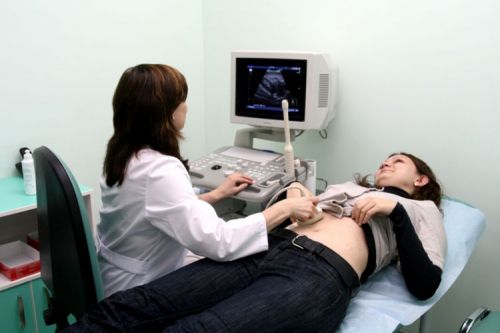
During the study, the patient should change the position of the body if foreign inclusions are found in the cavity of the gallbladder
A separate stage of cholelithiasis is the formation of stones that give a general acoustic shadow. This picture is observed in the presence of one large stone or many small ones that completely clog the lumen of the gallbladder. The image can be confused with gases, which will also look like bright spots. For a more complete picture, the patient can be given two yolks to drink and re-examine. When the digestion processes start, the gases will disappear, and the stones will remain in the cavity of the gallbladder.
Diffuse changes in echogenicity are rare. These include various sediments, pus or blood - substances that reflect ultrasonic rays and are distributed evenly, mixing with bile. They can be recognized by the following features:
- The sediment is located in the lower part of the gallbladder in an even layer, and above it is normal anechoic bile.
- If there is pus in the cavity, it first looks like a sediment. The only difference is that when the patient changes position, it mixes with bile. With chronic purulent process it can form characteristic septa in the bladder cavity, which are visible on ultrasound.
- Blood also needs to be differentiated from sediment and other diffuse inclusions. Over time, it folds and forms weakly echogenic clots that look like stones or polyps.
Echogenic inclusions can be found in the cavity of the gallbladder, which then turn out to be neoplasms. Their difference is that they grow from the wall and do not move when the patient's position changes. Tumors may be benign and not grow through the walls. If the patient is diagnosed malignant tumor, which means that it affects all layers of the gallbladder. Over time, the organ ceases to be detected on ultrasound due to necrosis of its wall.

Calculi (stones) look like light formations various shapes and size
Rules for ultrasound of the gallbladder
In order for the results of the study to be as reliable as possible, it is better to start preparing in advance. On initial examination The doctor will set a date for the examination and tell you how to properly prepare for it. The exception is emergency cases when there is a risk of blockage of the bile ducts by stones or an urgent operation is required.
For a planned ultrasound, the patient should follow a few simple rules:
- a week before the ultrasound, exclude alcohol from their diet, fatty foods and those that cause increased gas separation (carbonated drinks, yeast bread, raw fruits and vegetables, legumes);
- 3 days in advance, it is recommended to start taking drugs (Mezim, Espumizan and the like);
- before the study, you can not eat for 8 hours.
If an ultrasound is scheduled for the first half of the day, you should refuse breakfast and water. Dinner the day before should be no later than 19.00. If the procedure will be carried out in the evening, you can have breakfast around 7 o'clock in the morning.
Anechoic contents in the gallbladder are normal rate. He says that the bladder is filled with bile, in which there is no sediment or foreign matter. This important factor in the diagnosis of helminthiases, cholelithiasis and other pathologies. Also, an ultrasound of the gallbladder is included in a routine examination of the abdominal cavity. In addition to this indicator, pay attention to the size and shape of the organ, the thickness and uniformity of its walls. The indicators are written on the form and transferred to the attending physician, who then interprets them based on clinical signs.
Related videos
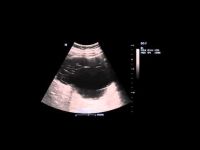
As its name suggests, the gallbladder stores bile produced by the liver. It has an elongated pear-shaped shape and is filled with viscous greenish bile, there is a bubble on the lower part of the liver and, together with it, is part of it. The sphincter of Lutkens regulates the flow of bile from the gallbladder cavity and back.
Bile is necessary for the digestion of fats, stimulation of intestinal peristalsis, neutralization of hydrochloric acid, which is formed in the stomach and enters the intestines, as well as to suppress putrefactive processes in the gastrointestinal tract. Various pathologies gallbladder disrupt these processes. They are detected on ultrasound of the gallbladder.
Indications for the appointment of ultrasound diagnostics
Treatment requires timely and correct diagnosis diseases. The most accurate and safe is ultrasound. Ultrasound of the gallbladder is prescribed to assess its condition, parameters, identify stones and developmental pathology.
They are referred for ultrasound of the gallbladder in the presence of one of the factors:
- pain in the right hypochondrium;
- suspicion of acute or chronic cholecystitis;
- suspicion of developmental anomalies;
- the presence of sand or stones;
- abdominal trauma;
- jaundice;
- pancreatitis;
- the presence of bitterness in the mouth, frequent nausea and vomiting with an admixture of bile.
 Pain in the region of the right hypochondrium may indicate serious pathological processes in the gallbladder. Therefore, with such complaints, the doctor prescribes an ultrasound of the organ and compares the result with the norm
Pain in the region of the right hypochondrium may indicate serious pathological processes in the gallbladder. Therefore, with such complaints, the doctor prescribes an ultrasound of the organ and compares the result with the norm Also, ultrasound of the gallbladder is done to monitor the patient's condition during treatment or after surgical intervention. The earlier any disease is diagnosed with the help of ultrasound of the gallbladder, the more effective its treatment will be.
Preliminary preparation
It is necessary to prepare for an ultrasound of the gallbladder in advance, 2-3 days before the procedure. Preparation for an ultrasound of the gallbladder takes place in the same way as. Special attention refers to the reduction of flatulence (gas formation and bloating). To prepare, you should:
- do not eat foods that cause bloating (cabbage, beans, black bread, raw vegetables and fruits)
- when preparing a child, exclude any carbonated drinks;
- completely abandon alcohol;
- do not eat fatty fish and meat;
- apply adsorbent, enzymatic and carminatives;
- in the presence of constipation, it is recommended to prepare more carefully and take lactulose before bedtime, and you can also use a glycerin suppository;
- dinner the day before should be light and nutritious;
- the last time you need to eat no later than 8 hours before the procedure;
- Ultrasound is performed strictly on an empty stomach, you can’t even drink water in the morning;
- if ultrasound has already been performed before, you should have a transcript and pictures with you to determine the dynamics.
Of course, very young children cannot stand this. long time no food, so to an infant Ultrasound is performed before the next feeding. For older children, you need to take food with you to feed after the procedure. If stones are suspected, the examination is carried out immediately, without pre-training.
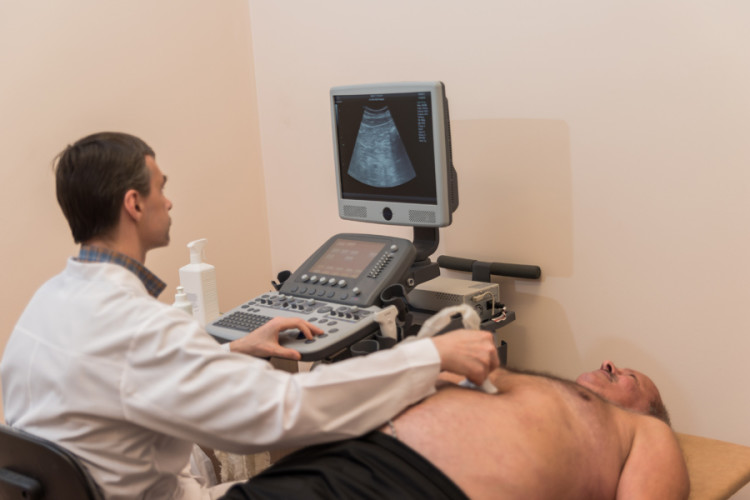 Preparation for ultrasound of the gallbladder in adults and children is aimed at reducing gas formation, since excess air will interfere with a detailed examination of the organ. Must comply special diet, and in some cases include the use of carminatives
Preparation for ultrasound of the gallbladder in adults and children is aimed at reducing gas formation, since excess air will interfere with a detailed examination of the organ. Must comply special diet, and in some cases include the use of carminatives Normal parameters of the gallbladder
During an ultrasound scan, a diagnostic specialist evaluates the shape and size of the gallbladder, the thickness of its walls, as well as the volume of bile, and compares these parameters with normal values. In an adult This organ normally has the following main parameters:
- length 40 - 95 mm;
- width 30 - 50 mm;
- transverse dimension 30 - 35 mm;
- wall thickness about 2 mm.
Also, with ultrasound of the gallbladder, the diameter of the common bile duct is measured, the norm of which is in the range of 6-8 mm, and the internal diameter of the lobar bile ducts, which should be no more than 3 mm.
Gallbladder norm parameters The child has depend on his age and fluctuate considerably. According to medical data, they should be:
| Age, years | Average length (range), mm | Average width (range), mm |
|---|---|---|
| 2 - 5 | 42 (29 - 52) | 17 (14 - 23) |
| 6 - 8 | 56 (44 - 74) | 18 (10 - 24) |
| 9 - 11 | 55 (34 - 65) | 19 (12 - 32) |
| 12 - 16 | 61 (38 - 80) | 20 (13 - 28) |
The gallbladder is considered healthy if it has normal form, and the dimensions and wall thickness correspond to the norm, bile is well excreted, no stones or sand were found in the cavity.
When examining a child (if it is not the first time), it is necessary to have a printout and transcript of past examinations with you. They must be shown to the doctor so that he compares the indicators and the dynamics of development.
Deviations from the norm: pathology and its signs
Most often found cholecystitis. At acute cholecystitis thickening of the wall, an increase in size, the formation of partitions in the cavity of the gallbladder are diagnosed. At chronic course the disease is a decrease in the bubble, thickening and compaction of the wall, as well as its deformation. On the monitor of the ultrasound machine, the wall has fuzzy contour and a lighter shade. Small particles are projected into the cavity.
At dyskinesia stagnation of bile is formed and the motility and tone of both the bladder itself and the bile ducts are disturbed. Structural changes can be seen on ultrasound: neck inflection and sealing of the bladder wall.
Cholelithiasis, or cholelithiasis, characterized by the presence of stones in the cavity and bile ducts. Light formations with dark areas behind them (the so-called acoustic shadow) are visible on the screen. When the position of the body changes, their movement in the bladder cavity is noticeable. The boundaries of the organ become uneven, there is a thickening of the wall. Sonography does not show small stones, but indirect sign- expansion of the duct above the place of its blockage. The frequency of stone formation increases with age, and women are diagnosed more often than men.
polyps they do not clinically manifest themselves on the walls, they are rounded formations up to 10 mm in diameter, they are usually detected during examination for other reasons. Unlike calculi, polyps do not produce an acoustic shadow on the ultrasound image.
Tumors of the gallbladder are characterized by deformation of the contours and a significant, relative to the norm, thickening of the wall. On echography, tumor-like formations or polyps larger than 20 mm are visible in the cavity.
 Cholecystitis on ultrasound is characterized by an increase in the size of the organ and thickening of its walls, as well as the appearance of new partitions, bubble inclusions. In the chronic course of the disease, the gallbladder can, on the contrary, become thinner and deformed.
Cholecystitis on ultrasound is characterized by an increase in the size of the organ and thickening of its walls, as well as the appearance of new partitions, bubble inclusions. In the chronic course of the disease, the gallbladder can, on the contrary, become thinner and deformed. Diagnostics with function definition
This type of diagnosis is carried out with dyskinesia (dysmotility of the walls with hypotonic or hypertonic type) And inflammatory diseases, which include cholecystitis (inflammation mainly in the bladder) and cholangitis (ducts become inflamed), as well as cholelithiasis.
Ultrasound is performed in a non-invasive way, it is the fastest, most informative, absolutely painless and safe method examinations. In just a few minutes, the doctor receives data on the parameters and shape of the organ being checked, wall thickness, existing defects, the presence and parameters of calculi.
Ultrasound of the gallbladder with the definition of function is carried out with the intake of a choleretic breakfast. It allows you to track the dynamics of the contractile-evacuation function.
The doctor conducting the ultrasound focuses on three main indicators: the time of the contraction period, the efficiency of bile secretion, the tone of the sphincter of Oddi. This procedure takes approximately one hour. Decryption is carried out immediately. Initially, the study is carried out on an empty stomach in a prone position, you can not even drink water. After the first scan, the subject should have two breakfasts. chicken yolks, or 250 ml of heavy cream or sour cream. You can also use a solution of sorbitol for these purposes. An echography is done after breakfast 3 times: after 5-10 minutes, after 20 minutes and after 40-45 minutes.
The readings are taken in different positions(lying on your back, on your side, standing, sitting, etc.). The dimensions of the bubble are measured in longitudinal and transverse sections, which makes it possible to more accurately and reliably assess the ducts and walls. If the bubble during the examination decreases in size by 60-70% of its original size, then it is considered that there are no violations contractile function. It should also be taken into account that with age there is a natural decrease in contractile function. Ultrasound of the gallbladder with the definition of function shows the most exact information about the state of the cavity and ducts. To obtain reliable testimony, the patient only needs to accurately follow all the instructions of the doctor.
Addresses medical centers and clinics in Moscow, where you can do an ultrasound of the gallbladder with the definition of function.
Ultrasound of the gallbladder with determination of function - non-invasive diagnostic procedure performed with a trial choleretic breakfast. To date, it is considered the only informative non-invasive method that allows you to study the state of the organ, as well as determine and evaluate changes in the functions of the organ in dynamics.
An important advantage of ultrasound of the gallbladder is the high accuracy of diagnosis and safety for the patient. Method Represents dynamic surveillance behind the rhythm of contractions at certain time intervals.
Indications
With the help of the study, such a common disease as. It allows you to define 5 degrees pathological changes(including recognizing the disease on initial stage), which will allow you to choose the right treatment.
The study helps to diagnose such anomalies as:
- agenesia;
- Hypoplasia;
- Intrahepatic gallbladder;
- Wandering gallbladder;
- Atresia of the bile ducts;
- Megalocholedochus.
Only timely diagnosis And operational assignment appropriate treatment can prevent complications and more severe course illness. Diseases of the gallbladder and liver can make themselves felt with the same symptoms, which include pain in epigastric region, deterioration and complete loss of appetite, nausea and vomiting. If you are experiencing:
- dull pain in the right hypochondrium;
- heaviness in the liver;
- jaundice skin;
- stool disorders;
- bloating, bitterness in the mouth, constipation;
- V biochemical analysis blood abnormalities of AST, ALT, bilirubin,
therefore, this study should be done to check the functioning of the gallbladder.
There are contraindications for research. If a patient is diagnosed with cholelithiasis, and in the lumen of the gallbladder there are a large number of stones that block the bile duct, then the examination will be uninformative.
How to properly prepare
The data obtained as a result of the procedure will show the state of the gallbladder, so you should strictly follow all the doctor's instructions for preparing for it.
- A week before the procedure, alcohol and gas-producing foods should be excluded from the menu, because if air bubbles enter the intestines, they will make it difficult to visualize. Gas-forming products include: crude whole milk, not thermally processed vegetables and fruits, legumes, muffins, black bread.
- 3 days before the study, you should start taking enzymes with pancreatin (Mezim, Creon). They are taken in microcapsules with a dose of at least 10,000 IU per meal. The microcapsule should be taken immediately before a meal or during a meal with boiled water. You can consult a doctor about the dosage, he can prescribe medicine with more high content enzymes. Also at the same time, they begin to take carminative drugs - espumizan, motilium, simethicone at the standard dosage. These medicines are taken after meals. For those suffering from chronic constipation, lactulose is recommended - one tablespoon in the evening before bedtime.
- On the day before the ultrasound, dinner should be nutritious and light: for example, cereal porridge without sugar. The last meal should be no later than 20.00 hours. After dinner, be sure to go to the toilet, and if you have problems, you can use a glycerin candle.
- In the morning, on the day of the study, do not have breakfast, boil the eggs and take the yolks with you. They will be necessary for the choleretic load. You can replace eggs with high fat sour cream. You can not eat or drink anything - even water, otherwise the gallbladder will shrink and the results will be unreliable. If the study will be conducted in the afternoon, then you need to have breakfast at 7 o'clock in the morning. Breakfast should be light food. Do not forget to take with you previous studies, test results that you have and a towel to wipe the gel after the study.
Features of the procedure
Ultrasound is done in several stages. First, a study is carried out at rest and the indicators of the gallbladder are recorded. The patient then has breakfast with two boiled egg yolks or 250 g of sour cream (a solution of sorbitol can be used) and after 10 minutes the functions of the gallbladder with ducts are again examined. Then 2 more times the study is carried out - both times after 15 minutes. This completes the study.
Unlike traditional ultrasound of the gallbladder, data are taken from the patient lying on his back, on his side, and sometimes the doctor will ask the patient to stand on his feet or on all fours. The duration of the procedure can be one to two hours.
Deciphering the results
In the process of diagnosis, the size of the organ in the longitudinal and transverse sections is precisely determined. By linear dimensions, you can accurately assess the condition of the walls and excretory ducts.
Norm indicators:
- the length of the gallbladder - from 4 cm to 14;
- width - from 2 cm to 4 cm;
- wall width - 4 mm;
- common bile duct diameter 6-8 mm;
- internal diameter of the lobar ducts up to 3 mm.
- shape - pear-shaped or cylindrical, clear contours;
- bubble volume: 30 - 70 cc
There should be no formations in the lumen. If an ultrasound scan detected a shadow from tumors or stones, then the presence and composition of stones are determined by its nature. Stones are adhering to the wall and wandering.
The doctor looks at 3 main characteristics:
- duration of the reduction period;
- bile secretion and efficiency;
- sphincter of Oddi tone.
Diagnostics allows you to determine changes in the motility of the gallbladder, the form of dyskinesia, the consistency of the contents.
Doctor's conclusion
When loaded after 45 min. after the start of the study, the gallbladder shrinks by 60-70% of its original size. In this case, the doctor writes a conclusion that the motor function of the gallbladder is not impaired. After 45 min. restoration of the volume of the organ begins due to the bile synthesized by the liver.
Addresses of medical centers and clinics in Moscow where you can do an ultrasound of the gallbladder.
Ultrasound of the gallbladder is a highly informative and non-invasive examination method that allows to detect during the procedure functional disorders in the organ and localize pathologies. Carried out in a medical institution by a specialist in the field functional diagnostics. If necessary ultrasound scan can be done at the patient's home. Despite the apparent simplicity and accessibility, preparation for this type of ultrasound takes at least 7 days.
Indications
Most often, the patient receives a referral for an ultrasound scan from a gastroenterologist, but others can also be sent for this procedure. narrow specialists e.g. pediatrician, surgeon, therapist. Exists whole line reasons that are a direct indication for ultrasound. First of all, they should include:
- Suspicion of cholecystitis, hepatitis, pancreatitis. Symptoms: pain under the ribs, yellowness of the skin and sclera.
- The need to control the dynamics of treatment, for example, inflammation and dyskinesia, the rate of dissolution of stones. Usually, several repeated scans are performed, which are necessary for the timely correction of the treatment regimen.
- Control examination before and after surgery to remove the gallbladder.
- Regular monitoring in the presence of chronic diseases of the gastrointestinal tract or for preventive purposes. The frequency of ultrasound is determined by the attending physician.
Preparation
In order to obtain diagnostically valuable results after scanning, several basic preparation rules must be observed:
- The intestinal cavity should be freed from gases, as they will interfere with adequate visualization of the organ.
- The last meal is allowed no later than 8 hours before the examination. At normal operation gallbladder and in the absence of food in the stomach - bile begins to accumulate in the bladder, which proportionally increases its size. If you start eating or drinking, then the bile will be excreted and the body will shrink. This will greatly complicate the study.
- A week before the procedure, the patient's diet is excluded. alcoholic drinks, fatty foods and foods that cause increased gas formation. And these are: sweet pastries, rye flour bread, raw vegetables and fruits, legumes, milk, snacks, soda.
- Three days before the ultrasound, an appointment is recommended enzyme preparations with each meal, but not more than three times a day. Choose the means of the pancreatic series. Dosage and regimen should be checked with your doctor. In the complex they begin to drink and carminatives, the purpose of which is to prevent the formation of gases. Adult dose: 1 tablet with food.
- On the eve of the diagnosis, you can have dinner no later than at 20.00. At the same time, meals should be hearty, but light. And 30 minutes after dinner, the intestines need to be emptied by taking a laxative or making an enema. Candles with glycerin or lacutlose preparations can be used. Those who suffer from chronic constipation should start taking carminatives well in advance.
- Immediately before the ultrasound, you should refrain from eating and drinking heavily.
If a scan is assigned to a child, then enzyme agents are not prescribed, but simply make adjustments to the diet. Children up to a year stop feeding 3 hours before the examination, up to 3 years - 4 hours, and from 8 years - 6 hours. At an older age, the same preparation rules apply as for adults, with dose correlation.
Features of the procedure
During the ultrasound, a special gel will be applied to the patient's abdomen to provide better adhesion between the scanning probe and the skin. After examination, it is wiped with a napkin. These actions do not pose any danger, since the gel is hypoallergenic. This survey carried out transabdominally, that is, percutaneously, scanning along the surface of the peritoneal wall.
The patient is placed on the couch, on his back. All manipulations are painless, except when constant pain served as a referral for ultrasound and are diagnostic criterion. The doctor of functional diagnostics will decipher the results immediately.
If all pre-procedure recommendations are followed Ultrasound will pass quickly and without discomfort. This will provide valuable data. There are no contraindications to this examination. If the patient has already had such an examination, then the sonologist needs to provide a past conclusion so that he would evaluate the dynamics if any. Often, the gallbladder is examined not separately, but during the examination of all organs of the peritoneum, general screening is much more expensive, but it provides more information and is prescribed to patients much more often.
Perhaps the patient will need an ultrasound of the gallbladder with a load, when before the procedure you will specifically need to eat a choleretic breakfast. During the scanning process, the doctor will monitor the function of bile secretion against the background of taking fatty foods. Usually, for this purpose, the patient consumes fatty dairy products or several boiled eggs. Indicators are measured linearly and several times, maintaining equal time intervals.
The standard procedure lasts 20 minutes, when using the load, the period increases depending on the volume of the study. Re-scanning can be done after 2 weeks, and in order to prevent it, it must be repeated once every 12 months.
What can be revealed
With the help of ultrasound, the following diseases and pathologies are diagnosed:
- Cholelithiasis.
- Cholecystitis in acute and chronic form.
- Dropsy.
- Cholangitis.
- Choledocholithiasis.
Norm indicators and decoding
First of all, the sonologist will describe the size and shape of the organ. These figures vary greatly depending on the age of the patient and general condition his body. On average, these figures should not go beyond the following limits:
- Length: 4 to 14 cm.
- Width: 2 to 4 cm.
- Wall thickness: approx. 4 mm.
In addition to the wall thickness, it is also important to describe the patency and width of the bile ducts, the presence of stones and foci of inflammation, the location of the bile duct relative to nearby organs and fabrics. The normal size of the bladder in infants and children under 8 years of age is determined based on the height and weight of the patient.
When testing with functional loads- the bubble normally shrinks by at least 70% of its original volume in 50 minutes. This suggests that the motility of the organ is without disturbance.
Doctor's conclusion
An extract from the results of ultrasound is issued in printed form. It reflects full information about the results of the examination and emphasized the detected pathologies. Attached are a number of high-resolution photographs.
The gallbladder is an integral part of the liver, which is involved in many important life processes. With inflammation and diseases, the patient has pain in the right hypochondrium and nausea, vomiting. At the first signs, it is necessary to seek the advice of a specialist for further examination.
The gallbladder is the "satellite" of the liver. It is located in anterior section right sulcus of the liver, somewhat reminiscent of a pear. It consists of: bottom, body, neck (continues into the bladder duct). Neck length - 35 mm. The common bile duct consists of the cystic and hepatic ducts. Length - 60-80 mm. The flow of bile and pancreatic juice is regulated by smooth muscle pulp.
The cells of the liver are responsible for the production of bile juice. This process is permanent and continuous. Bile juice enters the intestine through the duct system. Due to the absorption of water, the bile juice in this organ increases two to three times. The composition of bile: acid and pigments, cholesterol and bilirubin (is a consequence of the breakdown of hemoglobin). Partially excreted in human urine.
If blockage occurs biliary tract, That stool become bright and putrid smell. If a person has a metabolic disorder, then cholesterol can contribute to the formation of stones. Bile itself serves as a catalyst and is able to activate enzymes, breaks down fatty formations into small particles, helps to absorb fats and vitamins faster, enhances the functioning of the intestines.
The bile ducts help to release bile juice into the intestines. Foods such as meat, dairy products, and eggs contribute to a large release of bile. If there is no food in the intestines and stomach, then the flow of bile juice is negligible. The gallbladder is considered an auxiliary container for concentrated bile.
The norm of ultrasound in adults and children
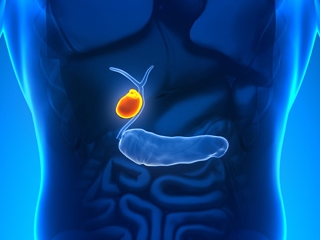 Ultrasound helps the specialist determine the presence pathological processes in the organ. This examination can be prescribed for both adults and children. Normal performance will also depend on age. Be sure the gallbladder should not be enlarged and have a clear outline. Normally, with ultrasound, the size of the gallbladder in an adult should be as follows:
Ultrasound helps the specialist determine the presence pathological processes in the organ. This examination can be prescribed for both adults and children. Normal performance will also depend on age. Be sure the gallbladder should not be enlarged and have a clear outline. Normally, with ultrasound, the size of the gallbladder in an adult should be as follows:
- The length of the organ is from 60 to 100 mm.
- Bubble width from 30 to 50 mm.
- The thickness of the walls is normally not more than 0.3 cm.
- The internal size according to the diameter of the lobar bile ducts is normally from 2 to 3 mm.
- Inner size by diameter common duct 0.6-0.8 cm are normal sizes.
- Normally, segmented and subsegmental bile ducts on ultrasound should not be traced.
As for the indicators of the gallbladder in normal ultrasound in children, they vary depending on age category baby. Therefore, after receiving the results of the examination, you should not engage in self-diagnosis and panic, but simply seek advice from a pediatric gastroenterologist.
The size of the gallbladder in children can vary within different limits. Most experts are of the opinion that the diameter should normally not be more than 35 mm, and the length - 75 mm. The volume in an older child is no more than 0.2 liters. Normally, the width of the common bile duct is 0.8 cm, and the size is 0.41 cm. normal condition bladder and the absence of pathologies in the liver, intrahepatic ducts should not be visible on ultrasound. If an ultrasound specialist found these ducts, then this indicates jaundice or cholestasis.
The size of the gallbladder in children on ultrasound, depending on age
If all sizes on ultrasound are normal, then this organ is healthy, there are no pathologies regarding the shape, seals and indicates normal excretion bile. Ultrasound is done to the child only if necessary and after a preliminary consultation and referral of a specialist.
Gallbladder Enlargement Factors in Children and Adults
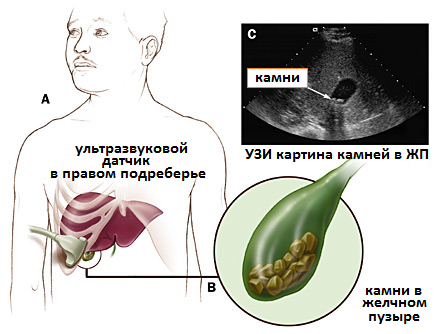 If enlarged sizes were replaced on ultrasound, then this may indicate violations in the functioning of the liver and bladder, as well as neoplasms and pathologies in development this body. Diseases are recognized as the main reasons for the increase in size:
If enlarged sizes were replaced on ultrasound, then this may indicate violations in the functioning of the liver and bladder, as well as neoplasms and pathologies in development this body. Diseases are recognized as the main reasons for the increase in size:
- Cholecystitis is a process of inflammation, accompanied by thickening of the wall of the organ. Signs: gag reflexes, weakened body, fever, pain in the right hypochondrium.
- Cholelithiasis. Sizes of stone formations: from the smallest and insignificant to the largest. Symptoms of the disease: nausea, gag reflexes, cramping pain in the right hypochondrium. Ultrasound helps to diagnose the size of stones.
- Dyskinesia - inflection of the neck and increased muscle tone of the walls of the bladder
As for the increase in the bladder in children, it is accompanied by diseases such as:
- Cholecystitis.
- Dyskinesia.
- Pancreatitis.
- Jaundice.
- Blockage of the bile ducts.
- Cholelithiasis and stones.
As shows medical practice, then ultrasound of the gallbladder is recognized as the safest, most informative way to diagnose diseases, both in adults and in children.

